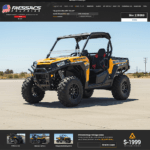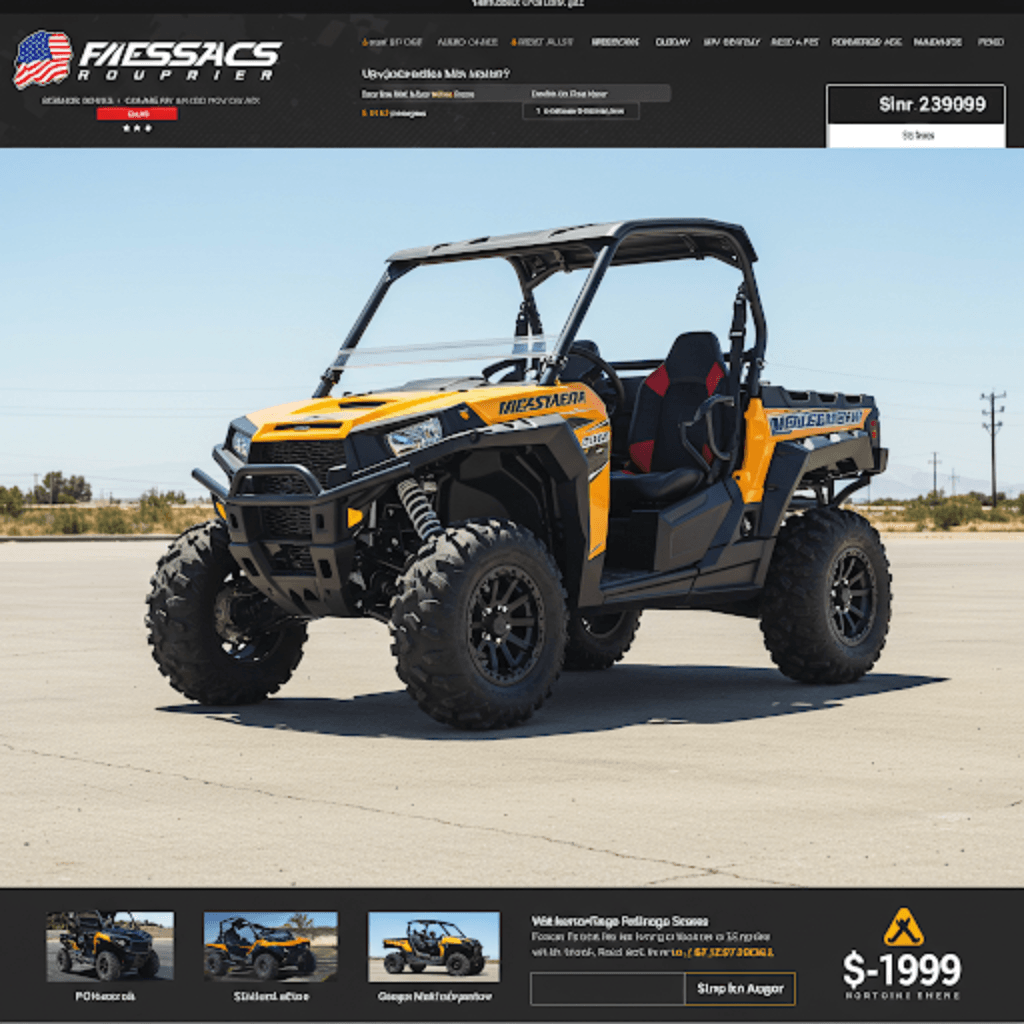
UTVs for sale: Your guide to choosing the right side-by-side
Utility Task Vehicles (UTVs), also popularly known as side-by-sides, have surged in popularity over the past few decades. They’ve transitioned from primarily work-focused vehicles to versatile machines used for recreation, farming, hunting, and even competitive racing. Finding the right UTV for sale can be a daunting task, with a seemingly endless array of brands, models, and features available. This guide will walk you through everything you need to know before you start your search, helping you make an informed decision and get the most out of your investment.
Understanding your needs: Work, recreation, or both?
The first, and perhaps most crucial, step is determining what you’ll primarily be using your UTV for. Are you a rancher needing a reliable workhorse to haul feed and mend fences? A weekend warrior seeking adrenaline-pumping trail rides? Or maybe a bit of both? Different UTVs are designed with different purposes in mind.
- Work-focused UTVs: These prioritize utility and durability. Expect features like large cargo beds, high towing capacities, and robust suspension systems designed to handle heavy loads and rough terrain. They often have lower top speeds and a focus on functionality over sportiness. Comfort features might be more basic, but reliability is key.

- Recreation-focused UTVs: These are built for fun and adventure. They typically have more powerful engines, longer-travel suspension for tackling challenging trails, and sportier handling. Comfort and style are often prioritized, with features like bucket seats, advanced sound systems, and aggressive styling.
- Crossover UTVs: These attempt to blend the best of both worlds. They offer a reasonable balance of utility and recreation, with decent cargo capacity and towing capabilities, along with comfortable seating and enough power for enjoyable trail riding. They may not excel in any one area, but they offer versatility for a variety of tasks.
Key features to consider
Once you’ve determined your primary usage, it’s time to delve into the specific features that matter most. Here are some key aspects to consider:
- Engine size and type: UTV engines range from smaller, single-cylinder engines to powerful, multi-cylinder options. Larger engines generally offer more power and towing capacity, but they also tend to consume more fuel. Consider the terrain you’ll be navigating and the loads you’ll be carrying when choosing an engine size. Four-stroke engines are the most common, offering a good balance of power and efficiency.
- Two-wheel drive (2WD) vs. Four-wheel drive (4WD): 2WD is sufficient for flat, relatively smooth terrain. 4WD is essential for tackling challenging off-road conditions, providing better traction and control on loose surfaces, steep inclines, and muddy trails. Some UTVs also offer selectable 4WD, allowing you to switch between 2WD and 4WD as needed.
- Suspension: Suspension is crucial for both comfort and performance. Longer-travel suspension provides a smoother ride on rough terrain and better handling at higher speeds. Consider the type of riding you’ll be doing and choose a suspension system that’s appropriate. Independent rear suspension (IRS) is common on many modern UTVs, offering improved handling and ride quality compared to solid-axle designs.
- Cargo bed capacity and towing capacity: If you plan to haul cargo, pay close attention to the cargo bed dimensions and weight capacity. Similarly, if you need to tow trailers or implements, check the UTV’s towing capacity. These specifications vary widely between models.
- Seating capacity: UTVs are available in a variety of seating configurations, from two-seaters to models that can accommodate six or more passengers. Choose a seating capacity that suits your needs and the number of people you typically plan to transport.
- Safety features: Safety should always be a top priority. Look for features like roll-over protective structures (ROPS), seat belts, and safety nets. Some UTVs also offer features like electronic power steering (EPS), which can reduce driver fatigue and improve control.
- Accessories and customization: The UTV aftermarket is vast, with a wide range of accessories available to customize your vehicle to your specific needs. Consider what accessories you might want, such as winches, roofs, windshields, lighting, and storage solutions, and factor that into your budget.
- Ground clearance: This is the distance between the lowest point of the UTV’s chassis and the ground. Higher ground clearance is essential for navigating rocky or uneven terrain without getting stuck.
Popular UTV brands
Several manufacturers dominate the UTV market, each with its strengths and weaknesses. Some of the most popular brands include:
- Polaris: Known for its wide range of models, from work-focused Rangers to high-performance RZRs. Polaris offers a UTV for virtually every need and budget.
- Can-Am: A strong competitor to Polaris, Can-Am offers a similar variety of models, with a focus on performance and innovation. Their Maverick line is particularly popular among sport enthusiasts.
- Yamaha: Renowned for its reliability and durability, Yamaha offers a range of UTVs, including the work-oriented Viking and the sport-focused YXZ.
- Honda: Honda’s UTVs are known for their build quality and engineering excellence. The Pioneer line is a popular choice for both work and recreation.
- Kawasaki: Kawasaki offers a range of durable and capable UTVs, including the Mule series, known for its workhorse capabilities, and the Teryx line, designed for recreation.
- John Deere: While primarily known for agricultural equipment, John Deere also produces a line of Gator UTVs, primarily focused on utility and work applications.
- Arctic Cat: Now part of Textron Off Road, Arctic Cat offers a range of UTVs known for their ruggedness and off-road capability.
New vs. Used UTVs
Deciding between a new and used UTV is a significant consideration. New UTVs offer the latest features, a full warranty, and the peace of mind of knowing the vehicle’s history. However, they come with a higher price tag. Used UTVs can be a more affordable option, but they may require more maintenance and may not come with a warranty. If you’re considering a used UTV, it’s essential to thoroughly inspect the vehicle, check its service history, and, if possible, have it inspected by a qualified mechanic.
Financing your UTV purchase
UTVs can be a significant investment, and many buyers choose to finance their purchase. Several financing options are available, including loans from banks, credit unions, and UTV dealerships. Compare interest rates and loan terms carefully to find the best deal. Consider your budget and ensure you can comfortably afford the monthly payments.
Maintaining your UTV
Regular maintenance is crucial to keep your UTV running smoothly and reliably. Follow the manufacturer’s recommended maintenance schedule, which typically includes oil changes, filter replacements, and inspections of various components. Proper maintenance will extend the life of your UTV and help prevent costly repairs down the road. Wash your UTV regularly to prevent corrosion, especially after riding in muddy or dusty conditions. Inspect the tires for wear and tear, and maintain proper tire pressure.
Where to buy a UTV
UTVs are sold through a variety of channels, including:
- Dealerships: Authorized UTV dealerships offer new and sometimes used models, along with service and parts departments. They can provide expert advice and financing options.
- Online marketplaces: Websites like Craigslist, Facebook Marketplace, and specialized UTV classifieds sites list both new and used UTVs for sale by private sellers and dealerships.
- Auctions: Auctions can be a good place to find deals on UTVs, but it’s important to be cautious and inspect the vehicles carefully before bidding.
Before you buy: Test drive and inspect
Before finalizing your purchase, always take a test drive. This will give you a feel for the UTV’s handling, power, and comfort. Pay attention to any unusual noises or vibrations. If you’re buying a used UTV, a thorough inspection is even more critical. Look for signs of wear and tear, damage, or neglect. Check the engine, transmission, suspension, and other key components. If you’re not mechanically inclined, consider having a qualified mechanic perform a pre-purchase inspection.
Choosing the right UTV involves careful consideration of your needs, budget, and preferences. By understanding the different types of UTVs, key features, and popular brands, you can narrow down your options and find the perfect side-by-side for your adventures. Remember to prioritize safety, perform regular maintenance, and always wear appropriate safety gear when operating your UTV.







